Moon Cactus Care: Guide For Growing Colorful Grafted Cactus (Gymnocalycium Mihanovichii)
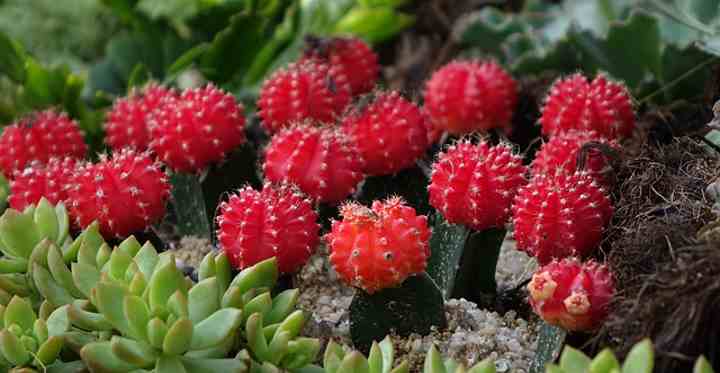
Moon cactus is a type of grafted cactus with a colorful ball-shaped top. These colorful cacti have become popular small houseplants that are very easy to care for. The cactus top is usually bright red, yellow, pink, or orange colors. This colorful top gives the appearance of a brightly-colored cactus flower. Some of these colorful cactus plants have multi-colored or variegated tops—but all have clusters of small, sharp spines running down the curved veins.
Moon cactus (Gymnocalycium mihanovichii) is also called Hibotan cactus, ruby ball cactus, or star flowered cactus. Moon cactus is a combination of two cacti that have been grafted together. The top cactus is the colorful Gymnocalycium mihanovichii cactus and the green lower cactus could be any cactus species. The cactus ball is usually between 1” and 2” (2.5 – 5 cm) and has prominent ribs on it.
How to care for moon cactus: Put the cactus in a warm, sunny place. The pot should have draining holes and contain a quick-draining cactus mix. Thoroughly water the plant only when the potting medium is dry. Fertilize monthly during spring and summer to grow a healthy, colorful cactus.
The best soil for moon cactus plants is aerated, sandy soil that allows water to drain well. Adding pebbles or small stones to a potting mix can also create suitable cactus soil. Like most types of succulents, cacti prefer a potting mix that is acidic to neutral.
Cacti – including the ruby ball cactus – are slow-growing plants and grow between 0.4” and 1.1” (1 – 3 cm) per year. Usually, moon cactus plants are sold almost fully grown.
Cactus plants can live from 10 to 200 years. Typically, cacti growing outside live longer than houseplant cacti; however, with the proper care, your indoor moon cactus plant can thrive for many years.
With the moon cactus, the length of time it lives is shorter than most cacti. Usually, these grafted cacti only live for a few years. Their shorter lifespan is due to the rootstock outgrowing the top part of the plant. To extend their lifespan, you need to re-graft the colorful ball cactus onto the rootstock. At the end of this article, you can find out how to care for your moon cactus by re-grafting it.
Grafted Cactus Origin
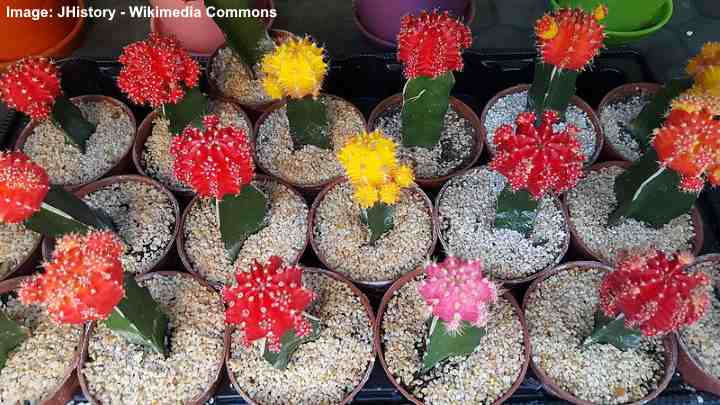
The colorful moon cactus (ruby ball cactus) gives a stunning look to any home or garden
The colorful cactus tops that you see for sale in many shops aren’t as vivid in the wild. This small cactus plant is native to Paraguay and Argentina. The bright red, pink, yellow, and orange colors are entirely natural.
These neon-bright colors develop in mutant Gymnocalycium mihanovichii plants that don’t produce chlorophyll—the substance that turns plants green. But without chlorophyll, cacti—and all other types of plants—would die off. So, to keep the cactus alive, the round cactus is grafted onto a regular cactus.
It is possible to use any species of cactus to create a colorful moon cactus (Hibotan). Usually, moon cactus for sale in garden centers use the cactus species Hylocereus for the stock. These green cacti have straight stems that have a star-shape on their cross-section. The shape of the stem is maybe a reason why this plant is called the star-flower cactus. The shape is perfect for grafting the ruby ball cactus on the top.
The stem cactus on the bottom feeds nutrients to the colorful cactus top. So, as long as you care properly for your plant, the grafted cactus will thrive.
How to Grow a Moon Cactus
Growing a Hibotan or star-flower cactus is straightforward. Despite being a grafted cactus, a moon cactus requires the same type of care as any succulent or cactus. The most important care tips to keep your moon cactus thriving is don’t over-water it and make sure both parts are always attached.
Let’s look in more detail at how to look after this little cactus plant.
How Much Light Does Moon Cactus Need?
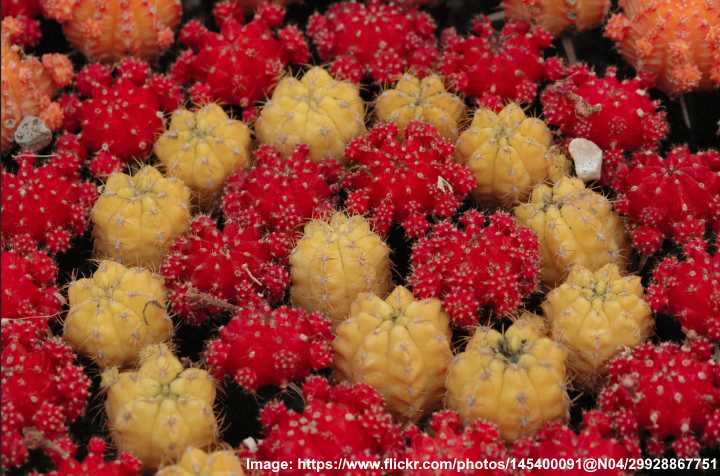
Moon cactus plants with red and yellow tops
A moon cactus needs plenty of bright, indirect sunlight. The grafted cactus on the top is quite shade-tolerant and doesn’t grow well in direct sunlight. The green stem cactus usually requires more direct sunlight. So, to grow a healthy moon cactus, you need the right balance of light.
The best location for a moon cactus is a bright area of your home. An east- or west-facing windowsill will provide plenty of bright light and limited direct sunlight. If your moon cactus is in a south-facing room, it is best to keep it back from the window to prevent plant burn.
If you notice that parts of your ruby ball cactus turn white (bleached) or develop scars, move it away from the sun. A plant turning yellow is also a reason for being in too much sunlight.
Water Requirements for a Grafted Cactus

Keep your moon cactus in well draining soil and avoid over-watering it
Moon cacti—like most types of cacti and succulents—are relatively drought-tolerant. The time to water your colorful plant is when the potting medium is nearly dry. When you water, pour enough water through the soil so it drains out the bottom. This process is called deep watering.
The frequency of watering a moon cactus plants depends on air temperature and humidity. During summer, you may need to water your small cactus weekly—however, always check the soil for dryness first of all. During fall and winter, you can hold off watering your plant. So, make sure that the potting mix is dry all winter. Occasionally misting your cactus houseplants helps to keep them healthy.
The worst thing you can do is allow the cactus potting mix to become soggy or mushy. Over-watering will result in root rot and will cause your plant to die. When deep watering, let all water drain out the pot before returning it to its tray. Water that collects in a dish or saucer under your container will soak back up into the soil and cause moisture problems.
Temperature for Moon Cactus
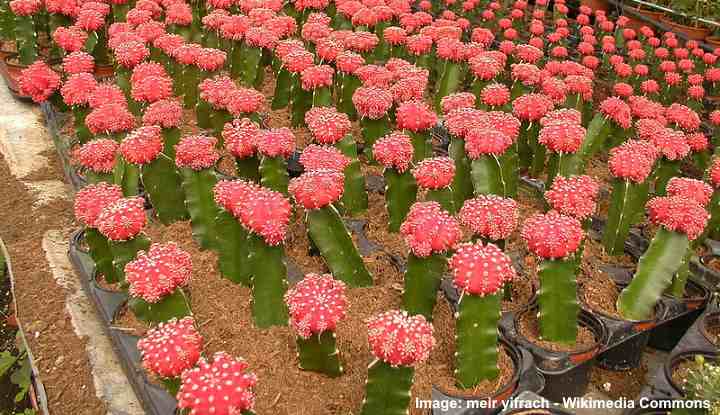
Moon cactus grows well in warmer temperatures in bright indirect sunlight
Moon cactus plants prefer warmer temperatures, and average room temperature should be ideal. Put your Hibotan plant near a window to give it the heat it needs to thrive—remember to provide shade from the scorching sun. Star-flower cacti grow best in temperatures 64°F to 77°F (18 – 25°C).
Similar to the moon cactus light requirements, the Gymnocalycium mihanovichii cactus has different care needs than the green stock when it comes to temperature. The base part of the moon cactus is hardier than the bright, colorful top.
You can successfully grow a moon cactus outdoors if you live in USDA zone 10 or 11. Find a bright location in your yard with partial shade to grow your cactus garden. If you live in temperate climates, you could transfer your cactus pots outside in summer. When the nighttime temperature starts to drop in the fall, return the plants indoors.
When growing your moon cactus indoors, keep it away from cold drafts—for example, open windows and air conditioning—and direct heat. Remember, moon cacti can’t survive temperatures below 48°F (9°C).
Humidity for Grafted Cacti

Grafted cactus with pink top
Ruby ball cactus plants are quite easy-going when it comes to their moisture needs. The small cactus houseplants thrive in relative humidity. But they can also survive well in low humidity levels. The most critical care advice is to make sure that the soil is always dry before adding moisture.
To keep the pink, red, orange or yellow colored cactus tops vibrant and healthy, you can mist them occasionally. Misting provides needed moisture without making the soil damp. Keeping humidity levels up during winter by misting the cactus is also good. From October until February, you shouldn’t water your moon cactus plants.
Feeding a Moon Cactus

Grafted cactus with red top
You don’t need to fertilize a ruby ball cactus often. If you use a good quality cactus mix, the soil should contain plenty of nutrients. However, monthly fertilizing in the growing season can encourage your grafted cactus to thrive. Choose an organic-based cactus fertilizer and mix it to the manufacturer’s instructions.
Top moon cactus care tip—flush the soil before monthly feeding. To do this, thoroughly water your cactus plant. Use enough water that is about four times the pot’s volume. Allow the water to drain completely before adding the cactus fertilizer.
Soil flushing prevents the buildup of mineral salts that can stunt cactus growth. Too much fertilizer can also result in a weak plant or yellowing. Remember not to feed your moon cactus during fall or winter.
How to Pot a Moon Cactus
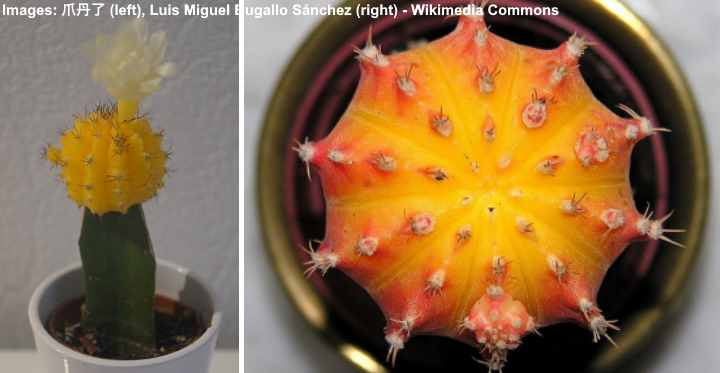
Moon cactus with yellow top and a flower (in the left image)
Most types of cacti and succulents—including ruby ball cactus—rarely require repotting. These hardy cacti grow well when they are slightly rootbound. The time to repot a colorful cactus is when its roots start poking out the pot’s drainage holes. Choose a new container that is slightly bigger.
The best time to repot your brightly-colored cactus is in late spring or early summer.
How to pot a moon cactus:
- One week before you plan to repot your cactus, thoroughly water it.
- When the soil has mostly dried out, carefully remove the moon cactus by pulling up the green stock—be careful not to dislodge the colorful top.
- Shake excess soil free and check for dead or diseased roots.
- Prune damaged roots as necessary.
- Fill a new pot up to halfway with good quality, organic cactus mix.
- Repot the cactus, making sure it is at the same height as before.
- Fill the pot with potting mix and gently press the soil around the rootstock.
- Place in a bright location away from direct sunlight.
It is best not to water your cactus for seven days to avoid the risk of root rot. Wait until the soil has dried out before thoroughly watering it.
The fresh soil will also boost cactus growth and extend your moon cactus plant’s lifespan.
Caring for a Moon Cactus in Winter
The best way to care for a ruby ball cactus in winter is to leave it alone. Succulents such as cacti go dormant in wintertime and don’t require any care. So, you shouldn’t water or feed your plant from September-October until February or March. Keeping the temperature warm enough is also essential to care for a moon cactus in winter.
A moon cactus can die if exposed to freezing temperatures. Always keep it in temperatures above 48°F (9°C) to avoid any risk of damaging the plant.
Propagating a Moon Cactus

Moon cactus cannot be propagated as it is a grafted cactus but the offsets can be grafted to a new rootstock
Because moon cactus plants are a type of grafted cactus, it is not possible to propagate them. If you want to extend the lifespan of your ruby ball cactus, you may need to learn some grafting skills. You can also graft a healthy G. mihanovichii with a healthy Hylocereus if you want to create your own, unique type of cactus.
How to re-graft a moon cactus
Re-grafting a moon cactus is necessary when you notice that the bright top is starting to separate from the green stock.
Here is the method to keep your moon cactus growing healthy:
- Sterilize a sharp knife and cut the colorful top part off the cactus.
- Cut off the top part of the green stock.
- Look for the circle of vascular tissue on both parts of the cacti—the rootstock and colored cactus ball.
- Place the two parts of the cacti together, lining up the two vascular circles.
- To hold the cactus ball in place, put rubber bands over the cactus and around the bottom of the pot.
- After a few weeks, the two parts of the cactus should start fusing to form a single plant.
Pruning a Ruby Ball (Moon) Cactus
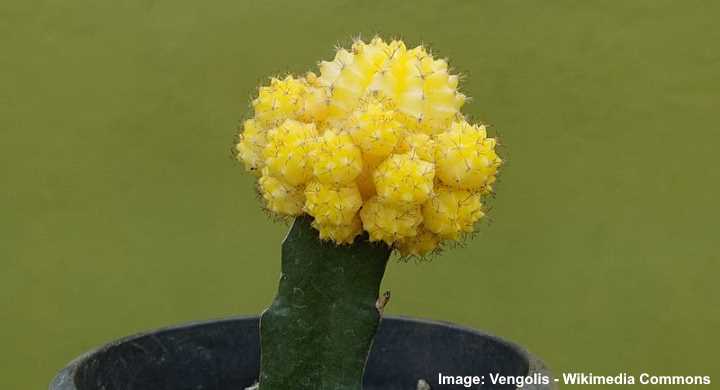
Yellow moon cactus with many offsets
A mature moon cactus plant that has been growing for many years will start to send out offsets. These are like miniature ruby ball cactus plants. You can prune these off the main plant. To propagate a new moon cactus, follow the grafting procedure mentioned in the previous care section.
Moon Cactus (Ruby Cactus) Flowers
Ruby ball cactus is a type of flowering cactus plant that produces brightly-colored flowers. Some people mistake the grafted colored cactus for a red or yellow cactus flower—however, this is part of the plant. Under the right conditions, a well-cared-for moon cactus will produce beautiful flowers.
What do moon cactus flowers look like? Small red, pink or white flowers grow at the end of a short stem. The cactus flowers in late spring or early summer. These grow from the colored cactus top, not from the green rootstock.
Moon Cactus Care: Common Problems
Water, moisture, and humidity issues are usually the most common problems to affect moon cacti. Not getting watering right can result in root rot (too much water) or, a withered plant—not enough water. So, if you notice that your moon cactus is dying and turning yellow, check that you’re watering it properly.
Too much sunlight is another reason why your ruby ball cactus is yellowing. You may also notice white scars on the cactus plant if it’s been too long in strong sunlight. So, if this is the case, move your cactus out of direct sunlight. Although moon cacti aren’t a low-light cactus, they withstand shade quite well.
What does it mean if your moon cactus is turning brown? A cactus that becomes brown is usually due to root rot caused by over-watering. To revive a dying cactus that has damaged roots, repot the plant as soon as possible. Only water your cactus when the soil has almost dried out.
If you care for your moon cactus well, it will keep its vibrant bright colors for many years.
Related articles:
